The Cathedral of St. John the Baptist is a must-see in Savannah, GA, and it only takes one quick glance to understand why. Its architecture is incredibly beautiful!
Even though most locals call it “The Cathedral” or “Cathedral St. John,” the church officially became known as the Cathedral Basilica of St. John the Baptist in 2020. (More on that below!)
If you’re wondering what all the fuss is about it, I’ll go through everything you need to know in this handy guide.
In case you’re curious, my personal favorite time to visit the cathedral is for Christmas in Savannah. That’s when it’s decorated with an elaborate nativity scene and thousands of live poinsettias.
If you can’t make it then, no worries; the Savannah cathedral is so impressive that it looks spectacular year-round. Case in point…
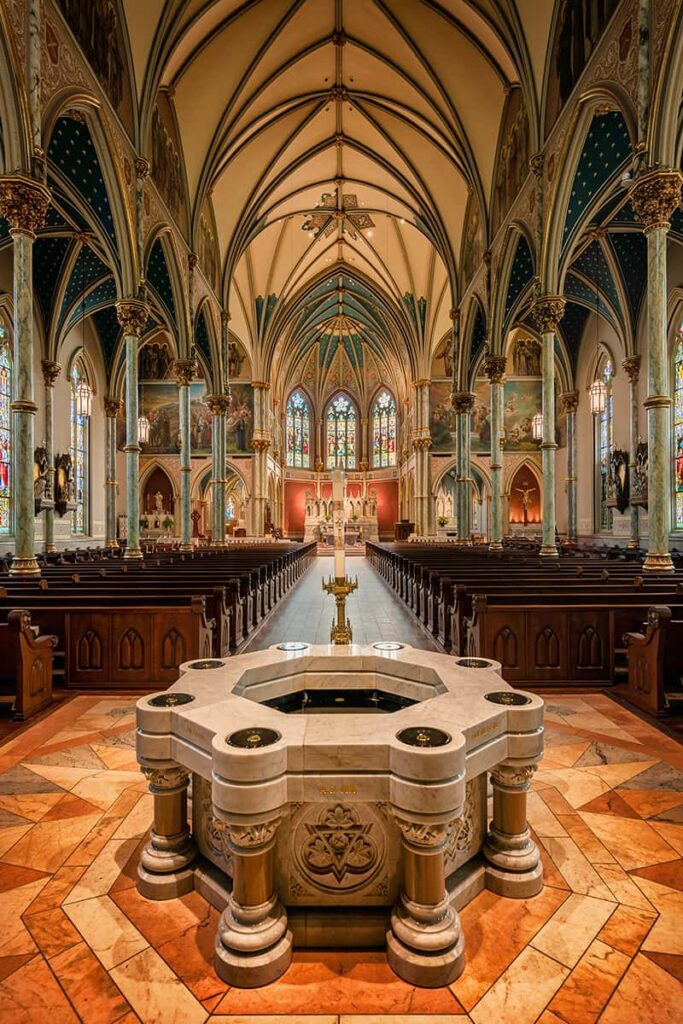
Note: This guide contains affiliate links to my trusted travel partners.
Table of Contents
Need to Know Info for Cathedral St. John
Location: Savannah Historic District
Address: 222 E Harris St, Savannah, GA 31401
Parking: Paid street parking is available in the area
Hours: Monday through Saturday: 9:30 a.m – 11:30 a.m and 12:45 p.m. – 4:30 p.m. and Sunday: 1 p.m – 4:30 p.m. | Doors close at 5 p.m. daily (on the dot)
Restrooms: Public restrooms are not available
Cost: $3 donation suggested
As long as you don’t have any mobility issues, you can walk to the cathedral pretty easily from any point in the Historic District or the Victorian District.
Its twin spires are so tall that you can SEE it from many points in both districts, as well!

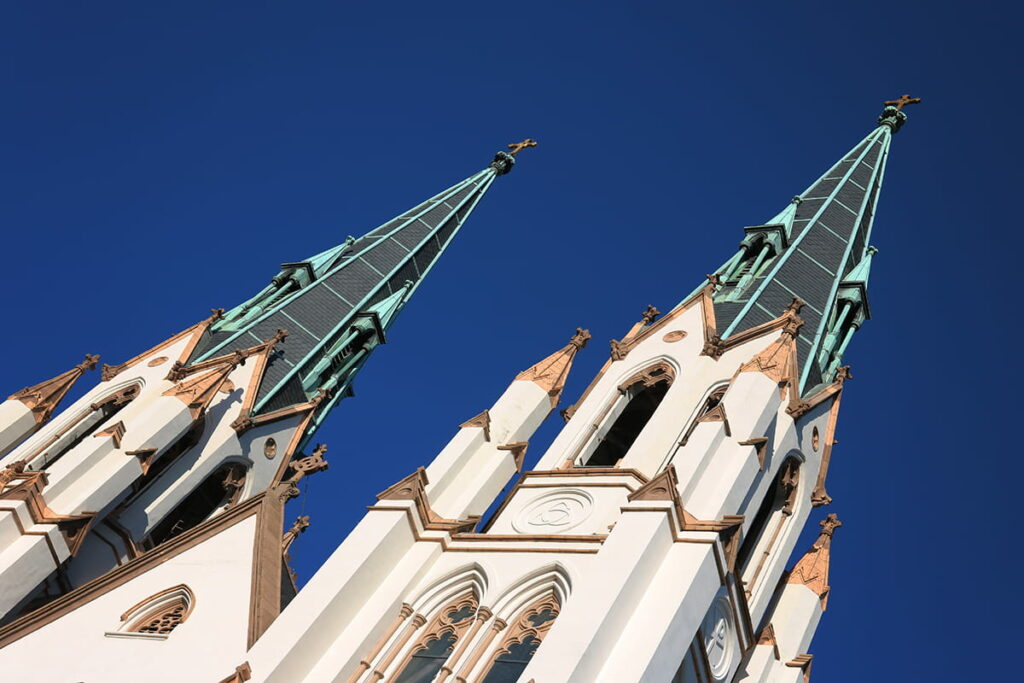
If you’re mobility-impaired or are staying in the Starland District, it might be easier to hop on the free DOT shuttle and then exit at the stop closest to Lafayette Square.
There’s always the option to take a guided (paid) trolley tour that stops at the cathedral, too.
Both of the hop-on/hop-off trolleys have a stop at the cathedral, so it doesn’t matter if you choose the white hop-on/hop-off trolley or the orange one.
If you opt for the white trolley, you can follow this handy Old Savannah trolley tour itinerary I created. Once you’re inside the cathedral, there are volunteer docents to answer your questions.
Related Reading: Savannah Trolley Tour Reviews: Which One is Best?
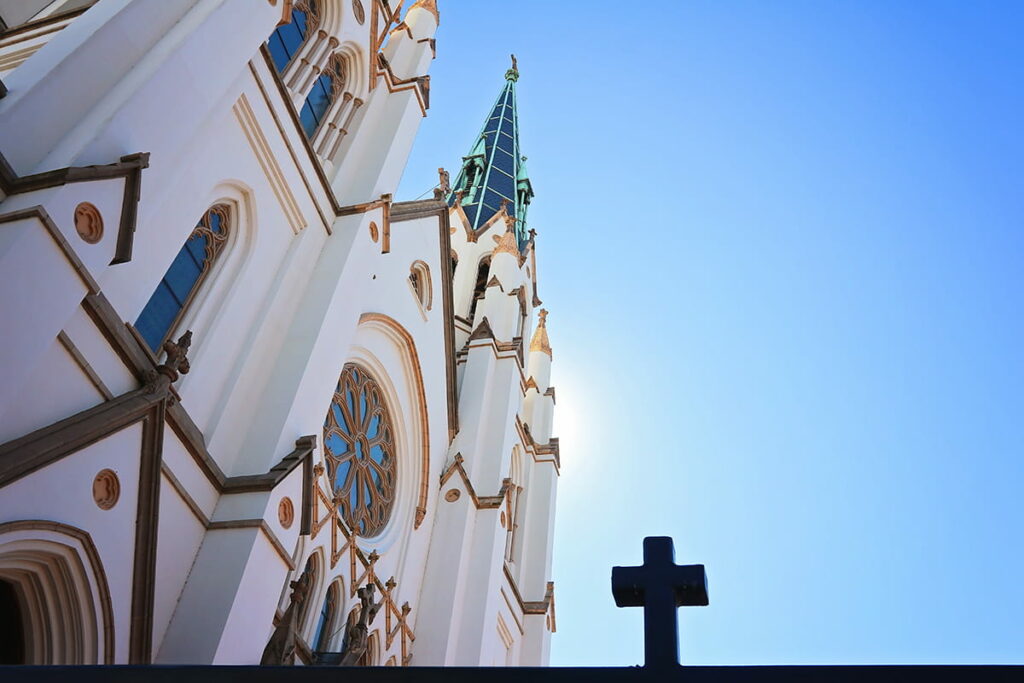
PLEASE NOTE: This is an active cathedral. Please be respectful of anyone who is visiting the church to pray, and be cognizant of how your actions might affect others inside the building.
What to See Inside the Savannah Cathedral
Once you step inside the Cathedral of Saint John the Baptist, it’s easy to become overwhelmed with its beauty.
I’ve visited many times, and I’m still in awe each time I go!
To help you out, here a few things you won’t want to miss (I’ll go in order beginning when you enter the nave and turn to the right)…
That Cavernous Ceiling
You shouldn’t have any problem noticing the tall ceilings as soon as you walk in, since your eye is immediately drawn to their height. At the tallest points, they reach 96 feet high!
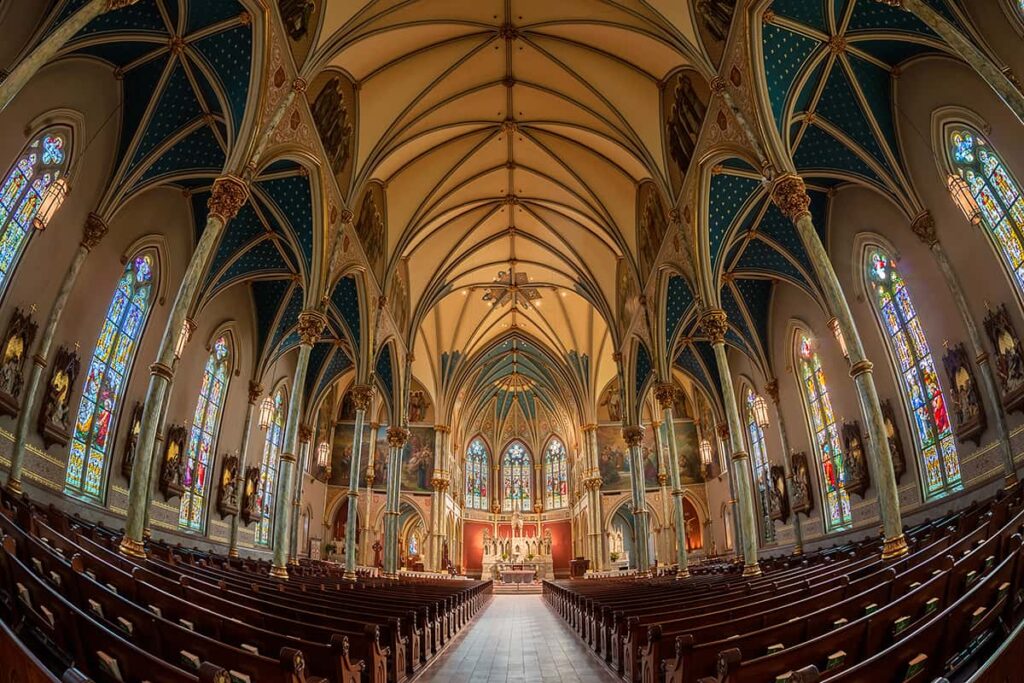
There are murals along each side of the ceiling, too. If you look closely, you’ll see the Procession of the Saints marching along on the ceiling above the center aisle.
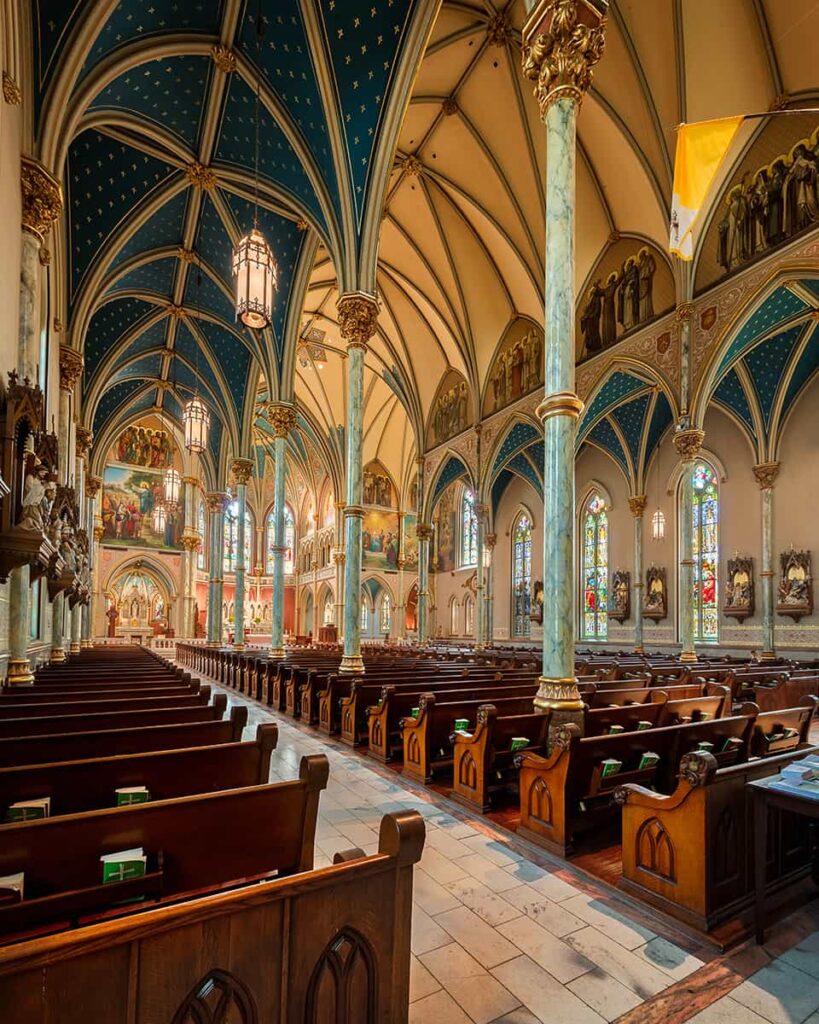

The north and south-facing portions of the ceiling are each painted in a deep peacock-blue color with tiny, hand-painted gold emblems.
The Baptismal Font
You also can’t miss the striking baptismal font, since it sits directly in the aisle as soon as you walk through the doorway.
It’s octagon-shaped and weighs a whopping 8,000 pounds.
The tile inside the font is shaped like a Celtic knot in a nod to Savannah’s Irish heritage.
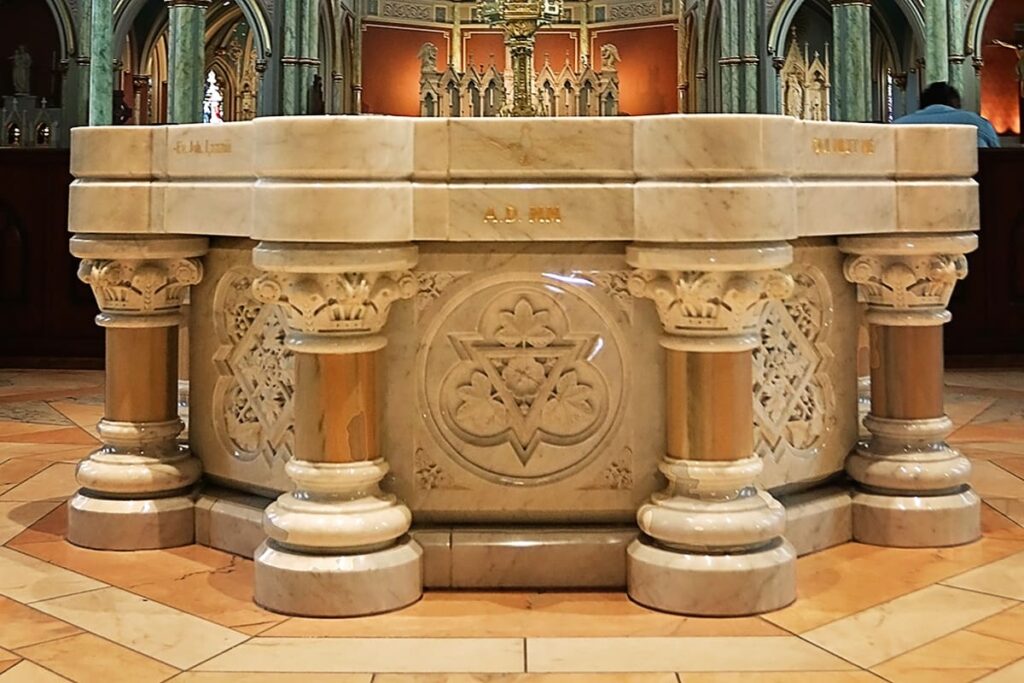
The Stations of the Cross
There are a total of 14 Stations of the Cross in the cathedral. Each one is hand-carved out of linden wood and is very detailed.
The statues were carved in Bavaria, Germany by many different wood carvers.
However, to provide continuity between the many carvings, the face of Christ on every single station was carved by the same exact artist.
The stations depict the Passion of Christ, and each one appears in order. They go from condemnation by Pontius Pilate to crucifixion and death to burial.
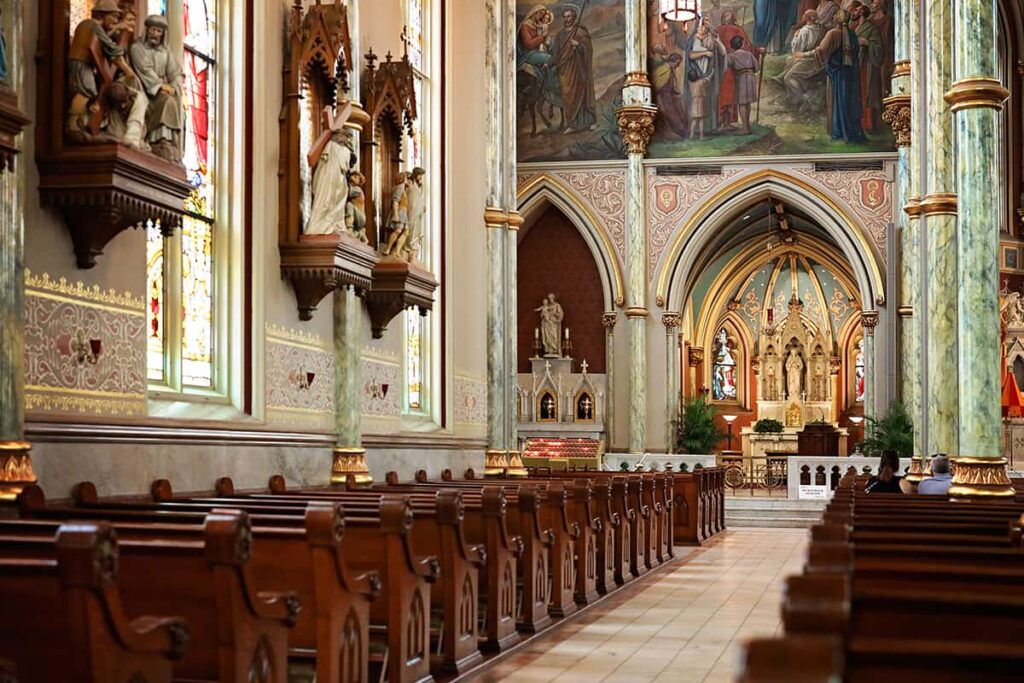
The Crucifix
As you walk towards the pulpit area, the crucifix is located just in front of the south transept on the right-hand side of the cathedral.
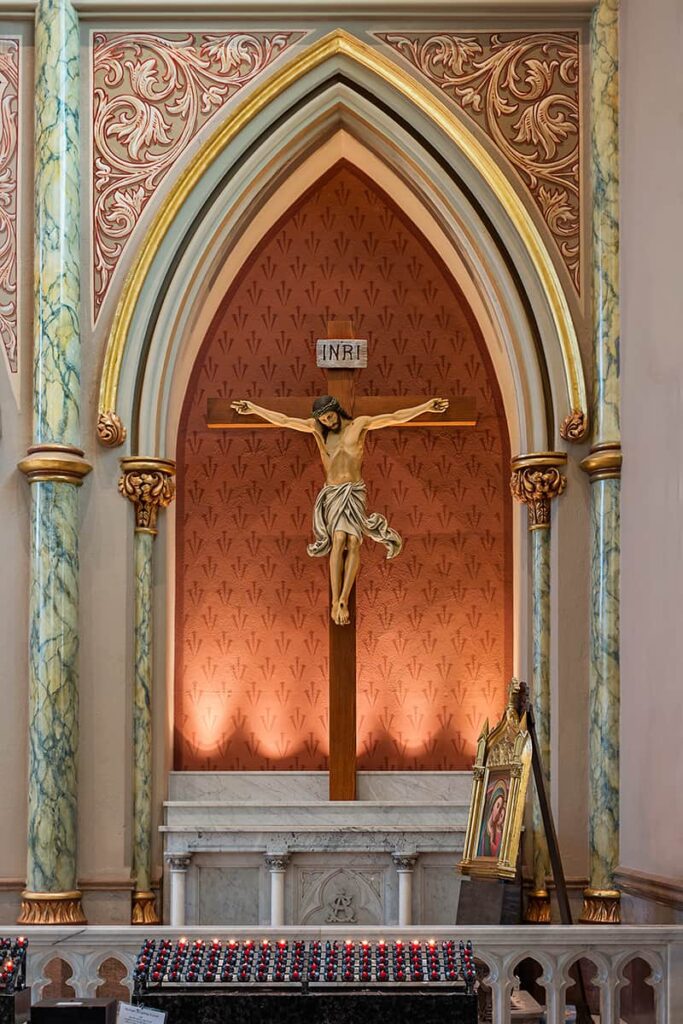
It has been restored and sits atop the altar of Saint Anthony, with an oil painting of Mother Mary to the right of it.
The Virgin Mother Mary Altar
This altar is situated between the crucifix and main altar, and the walls are painted a pale robin’s egg blue.
The Original Altar
There’s a massive marble structure beneath the curved stained glass windows of the cathedral. It used to serve as the original altar, but these days it’s a backdrop.
In case you weren’t aware (I certainly wasn’t, until I started doing research for this post), priests used to turn their backs to parishioners and face the altar while preaching to it in Latin.
I can’t imagine many things more boring than that.
At some point in the 1960s, a wise pope decided that priests should face parishioners instead of the wall, and thus the original altar switched to backdrop status.
The new setup makes it much harder to fall asleep during service without a priest taking notice!
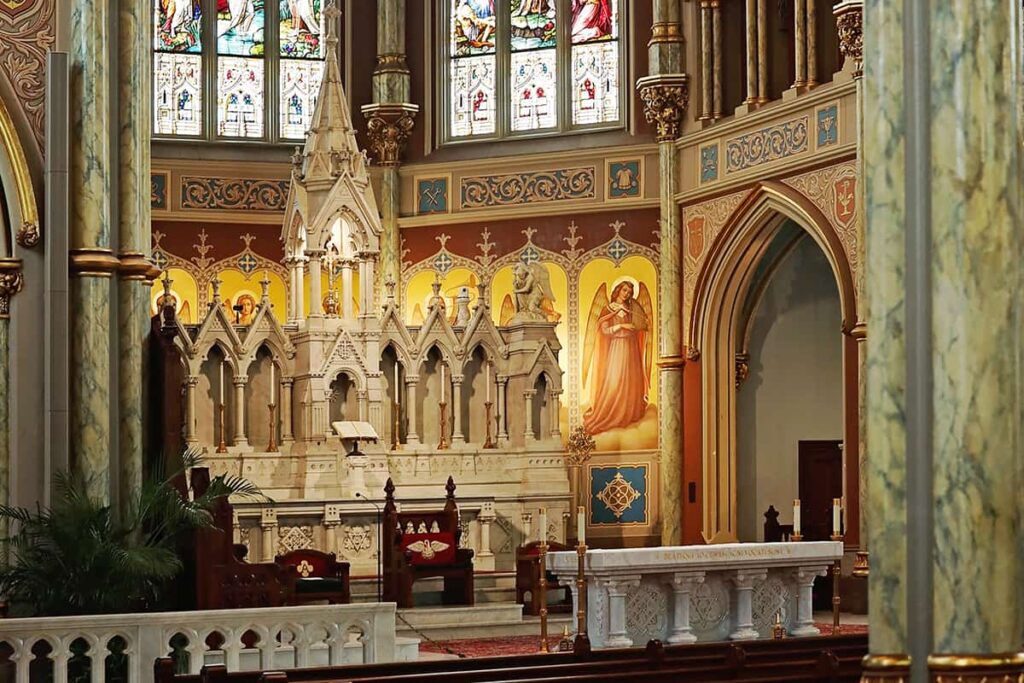
The Modern-Day Altar
The modern-day altar is smaller and closer to the pews so priests can better communicate with parishioners.
Even though it looks more humble than the original altar, it’s still a massive chunk of Carrara marble. It clocks in at 9,000 pounds!
Blessed Sacrament Altar and Tabernacle
This is the most sacred area of the cathedral, because this is where the Eucharist resides once communion ends.
Whenever parishioners partake in communion, any of the leftover host is placed inside the tabernacle (aka: behind the small brass door) where it is reserved for the next service.
Anytime you visit a Catholic church and want to know where the tabernacle is located, just look for the red candle. Whenever that candle is lit, it means Christ is present in the tabernacle.
The red candle stays lit for 362 days of the year.
To represent the days prior to Christ’s resurrection, the candle is unlit for three days during Holy Week. The door to the tabernacle is also left open during those three days.
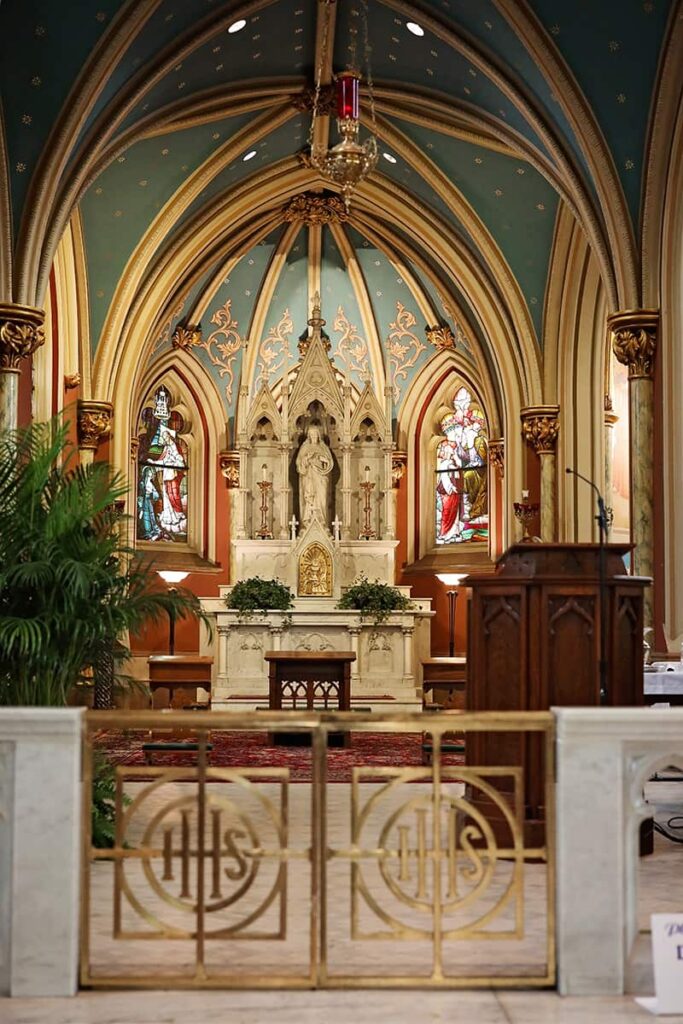
Holy Oils Ambry
The Holy Oils Ambry is located in the north transept. It has three different vessels that hold the oils used in baptisms, confirmations, and last rites.
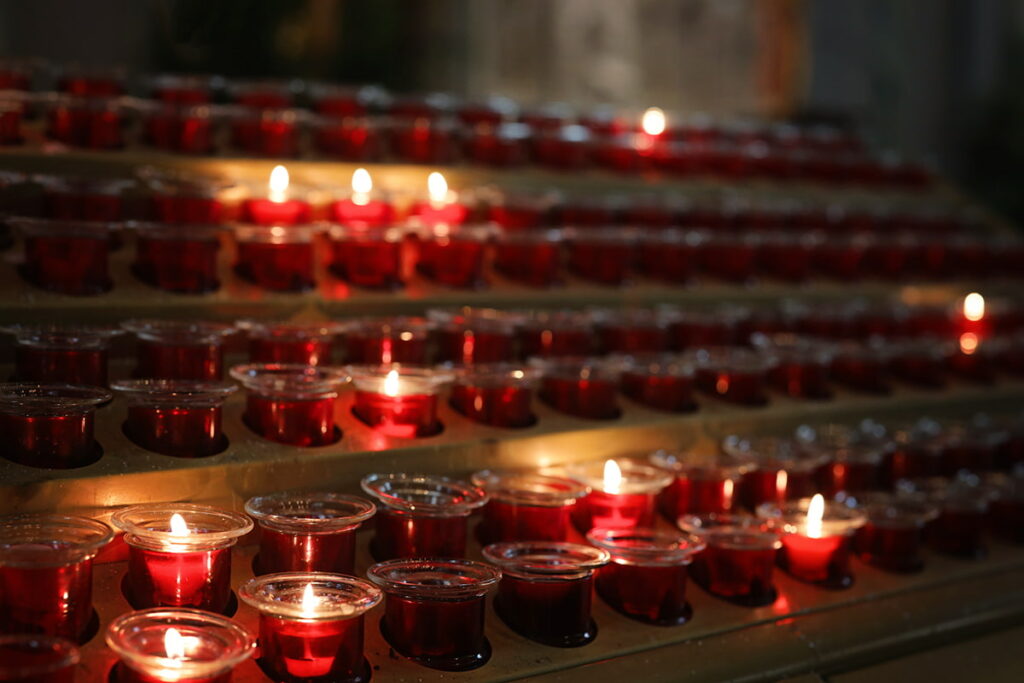
Confessional
The confessional is located in the north-facing transept and is made of wood and glass. The glass features etchings that tell the story of the Prodigal Son.
Pipe Organ
As you’re headed out of the cathedral, don’t forget to look up again!
The pipe organ is located in a loft above the nave, and it something you don’t want to miss. It’s made from more than 2,300 pipes.
The surrounding case is solid oak trimmed in black walnut, and it’s quite a work of art!
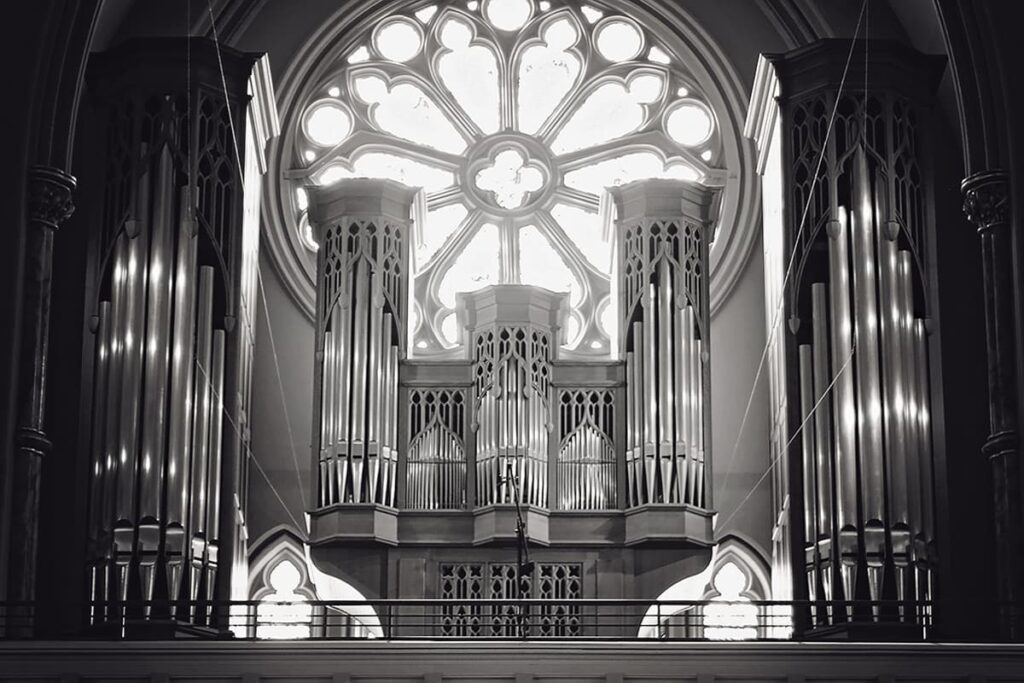
Stained Glass
The stained glass pieces throughout the cathedral depict important events in Biblical history.
I haven’t mentioned it yet, but the majority of the cathedral burned in the late 1800s. Much of the original stained glass was lost at that time — only three pieces survived the blaze.
Although you can’t see it easily during a general walk-through of the cathedral, one of the surviving sections is located in the Blessed Virgin Chapel.
The Great Rose is the easiest piece of stained glass to spot from the exterior of the cathedral. However, it’s the easiest to miss once you’re inside. That’s because it’s located high above the choir loft.
It’s 20 feet in diameter and features St. Cecilia, the patroness of music, in the center. That window alone is insured for more than 3 million dollars!
(Just imagine how much insurance costs for the entire building! Yikes.)
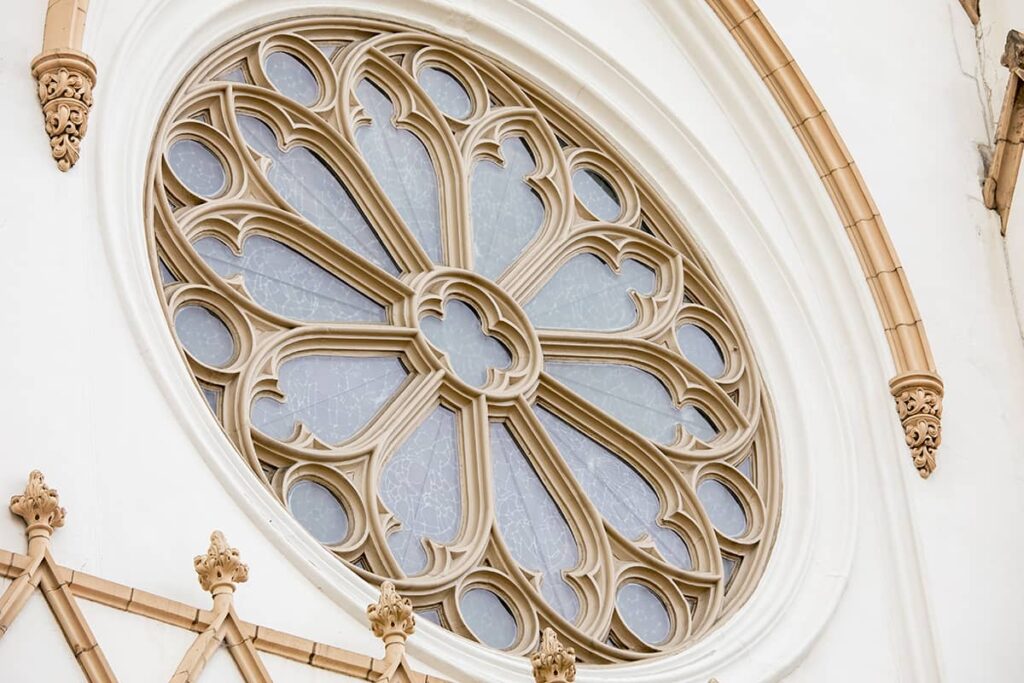
“Marble” Columns
The marble columns throughout the Cathedral of St. John the Baptist are actually faux!
They’re painted to look like real marble, but they’re really made of steel. That’s because real marble would crush under the weight of the building.
The Donation Box
There’s a donation box posted near the door to the narthex with signage suggesting a $3 donation to help with the upkeep of the cathedral.
Here’s the thing, though…
Should you Donate to the Cathedral?
Catholic dioceses have paid out more than 3 billion dollars in sexual abuse settlement funds in the United States in recent decades [source].
The U.S. Catholic Church has also spent more than 10 million dollars lobbying against bills that make it easier for victims to sue for alleged abuse [source].
If you like the building and want to donate, I suggest donating directly to the Cathedral Basilica Heritage Endowment Fund. Those funds are earmarked specifically for the preservation of the building and won’t (or at least shouldn’t) go towards any political agendas.

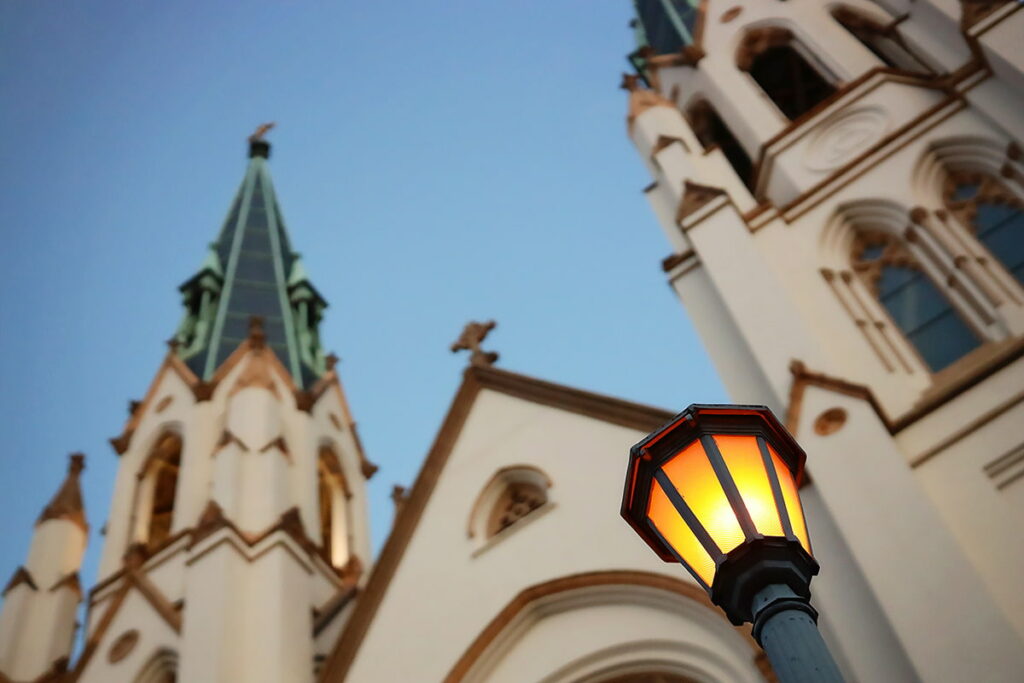
Why the Savannah Cathedral was Designated a Basilica
St. John was designated a Minor Basilica in 2020 by His Holiness Pope Francis. This is pretty significant, since there are only 18 cathedrals in the United States with the Basilica designation.
Minor Basilicas receive the designation due to their historical importance, architectural value, and their significance as a place of worship.
Mass at the Cathedral of St. John the Baptist
The Savannah cathedral holds mass a couple times each day, and the public is welcome to attend.
Hours for Mass
- Sunday (3x): 8:00 a.m., 10:00 a.m., and 11:30 a.m.
- Monday – Friday (2x daily): 7:30 a.m. and 12:00 noon
- Saturday (2x): 12:00 noon and 5:30 p.m.
Christmas and Easter services are always crowded, and sometimes they’re standing room only.
Cathedral of Saint John the Baptist Summary
Overall, the cathedral is fascinating and one of the prettier churches you can tour in Savannah.
Two additional places of worship I highly suggest checking out are First African Baptist Church and Congregation Mickve Israel. The latter has the oldest Torah in the United States!
If you’re overwhelmed with your trip planning, my Savannah First-Timer’s Guide might help. It has all of my top Savannah tips neatly packaged into one handy downloadable ebook.
